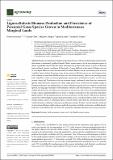Por favor, use este identificador para citar o enlazar a este item:
http://hdl.handle.net/10261/266465COMPARTIR / EXPORTAR:
 SHARE SHARE
 CORE
BASE CORE
BASE
|
|
| Visualizar otros formatos: MARC | Dublin Core | RDF | ORE | MODS | METS | DIDL | DATACITE | |

| Título: | Lignocellulosic biomass production and persistence of perennial grass species grown in mediterranean marginal lands |
Autor: | Sacristán, Daniel; Cifre, Josep; Llompart, Miquel; Jaume, Jaume; Gulías, Javier | Palabras clave: | Biomass yield Perennial grasses Survival Mediterranean region |
Fecha de publicación: | 2021 | Editor: | Multidisciplinary Digital Publishing Institute | Citación: | Agronomy 11(10): 2060 (2021) | Resumen: | Biomass production in marginal lands represents one of the most challenging and promising alternatives to sustainably produce biofuels. Native species seem to be the most adequate option to obtain a profitable output when low-input techniques are applied, and biomass is grown in depleted soils and harsh climatic conditions. In this study, a 5-year field trial in the island of Majorca served to investigate different autochthonous and naturalized Mediterranean perennial grasses as novel candidate lignocellulosic bioenergy crops for the semi-arid Mediterranean area and compare them with commercial ones (both Mediterranean and non-Mediterranean). Species and growing season had a significant effect on biomass production, perennialism and biomass quality. Arundo donax (winter crops) and Piptatherum miliaceum (autumn crops) performed better than the commercial species tested (Panicum virgatum for winter crops and Festuca arundinacea for autumn crops) in biomass production and perennialism. In terms of biomass quality, Panicum virgatum was the best species, having high structural content (mainly cellulose and hemicellulose), low non-structural content and the lowest ash. However, Ampelodesmos mauritanicus and Arundo donax rendered similar results, with no significant difference in terms of cellulose production for this latter but with higher lignin content. For the autumn species, Festuca arundinacea was the species with the best biomass quality but with the highest ash production for all the species considered. Hence, both for winter or autumn regimes, native or naturalized plants seem to be better suited than the commercial commonly used for biomass production with energy-producing purposes. Further research must be conducted in terms of seed biology and physiology, seedbed preparation methods, sowing time, seedling density and weed control before they can firmly be proposed as adequate alternatives for energy purposes. | Descripción: | © 2021 by the authors. | Versión del editor: | http://dx.doi.org/10.3390/agronomy11102060 | URI: | http://hdl.handle.net/10261/266465 | DOI: | 10.3390/agronomy11102060 | E-ISSN: | 2073-4395 |
| Aparece en las colecciones: | (CIDE) Artículos |
Ficheros en este ítem:
| Fichero | Descripción | Tamaño | Formato | |
|---|---|---|---|---|
| Lignocellulosic_Biomass_Sacristán_PV_Art2021.pdf | 1,03 MB | Adobe PDF |  Visualizar/Abrir |
CORE Recommender
SCOPUSTM
Citations
4
checked on 11-may-2024
WEB OF SCIENCETM
Citations
4
checked on 27-feb-2024
Page view(s)
33
checked on 15-may-2024
Download(s)
68
checked on 15-may-2024
Google ScholarTM
Check
Altmetric
Altmetric
Este item está licenciado bajo una Licencia Creative Commons

